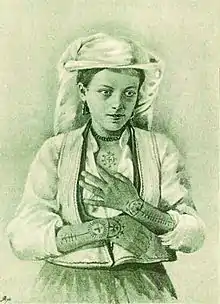Christian tattooing in Bosnia and Herzegovina
Christian tattooing in Bosnia and Herzegovina (or sicanje in Serbo-Croatian) was a widespread custom among Roman Catholics during the Ottoman rule over Bosnia and Herzegovina (1463–1878)[1] and up until the 20th century. Catholics tattooed their children in order to save them from devşirme, while women were tattooed in hopes of avoiding enslavement.

The custom is thought to predate the Slavic migration to the Balkans and even Christianity. In the 1st century BC, the Greek historian Strabo mentioned tattooing among inhabitants of this area,[2] along with another Illyrian custom.[3] Vlach females from Greece, Macedonia and Herzegovina also utilized tattoos.[4] Archaeologist Ćiro Truhelka researched these types of tattoos in the late 19th century, becoming one of the first to write about them and to illustrate them.[5][6]
Bosnian women in some parts of the country tattoo their hands and other visible parts of the body (such as brow, cheeks, wrist, or below the neck) with Christian symbols and stećak ornaments. This can be seen today, not only in Bosnia and Herzegovina, but among Bosnian women living abroad.[7][8]
References
- The Early Age of Greece; Cambridge University Press, p493-496
- Ćiro Truhelka:Die Tätowirung bei den Katholiken Bosniens und der Hercegovina (published in Wissenschaftliche Mittheilungen Aus Bosnien und der Hercegovina, herausgegeben vom Bosnisch-Hercegovinischen Landesmuseum in Sarajevo, redigiert von Dr. Moriz Hoernes, Vierter Band, Wien 1896)
- Albania and the Albanians: selected articles and letters 1903-1944, by M. Edith Durham, Harry Hodgkinson, Bejtullah D. Destani
- "Oldest Tattoo Shop in Greece by Lars Krutak". The Vanishing Tattoo. Retrieved 4 November 2020.
- Truhelka, Ciro. Wissenschaftliche Mittheilungen Aus Bosnien und der Hercegovina: "Die Tätowirung bei den Katholiken Bosniens und der Hercegovina." Sarajevo; Bosnian National Museum, 1896.
- Lipa, Aida (26 May 2006). "THE AUSTRO-HUNGARIAN PERIOD IN BOSNIA AND HERZEGOVINACultural Politics in Bosnia and Herzegovina and the Creation of the Western Type of Art" (PDF). Kakanien Revisited. Retrieved 4 November 2020.
- "Croats in Bosnia and Herzegovina". www.croatianhistory.net. CROATIA - overview of. Retrieved 4 November 2020.
- Herzl Gaster, Theodor (1 January 1955). Customs and folkways of Jewish life. W. Sloane Associates. p. 256.
